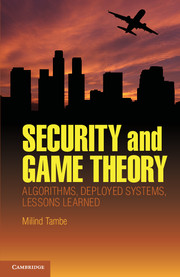Book contents
- Frontmatter
- Contents
- Acknowledgments
- 1 Introduction and Overview of Security Games
- PART I SECURITY EXPERTS' PERSPECTIVES
- PART II DEPLOYED APPLICATIONS
- PART III EFFICIENT ALGORITHMS FOR MASSIVE SECURITY GAMES
- 7 Coordinating Randomized Policies for Increasing the Security of Agent Systems
- 8 Computing Optimal Randomized Resource Allocations for Massive Security Games
- 9 Security Games with Arbitrary Schedules: A Branch-and-Price Approach
- PART IV FUTURE RESEARCH
- PART V SHORT BIOS
- References
- Index
- References
7 - Coordinating Randomized Policies for Increasing the Security of Agent Systems
from PART III - EFFICIENT ALGORITHMS FOR MASSIVE SECURITY GAMES
Published online by Cambridge University Press: 05 January 2012
- Frontmatter
- Contents
- Acknowledgments
- 1 Introduction and Overview of Security Games
- PART I SECURITY EXPERTS' PERSPECTIVES
- PART II DEPLOYED APPLICATIONS
- PART III EFFICIENT ALGORITHMS FOR MASSIVE SECURITY GAMES
- 7 Coordinating Randomized Policies for Increasing the Security of Agent Systems
- 8 Computing Optimal Randomized Resource Allocations for Massive Security Games
- 9 Security Games with Arbitrary Schedules: A Branch-and-Price Approach
- PART IV FUTURE RESEARCH
- PART V SHORT BIOS
- References
- Index
- References
Summary
Introduction
Security, commonly defined as the ability to deal with intentional threats from other agents, is a major challenge for agents deployed in adversarial environments (Paruchuri et al., 2006). In this paper, we focus on adversarial domains in which the agents have limited information about the adversaries. Such adversarial scenarios arise in a wide variety of situations that are becoming increasingly important, such as patrol agents providing security for a group of houses or regions (Carroll et al., 2005; Paruchuri et al., 2007), UAVs monitoring a humanitarian mission (Beard and Mclain, 2003; Paruchuri et al., 2006), agents assisting in routine security checks at airports (Poole and Passantino, 2003), agents providing privacy in sensor network routing (Ozturk, Zhang, and Trappe, 2004), and agents maintaining anonymity in peer-to-peer networks (Borisov and Waddle, 2005).
This paper brings together some of our recent work on how to plan for agents acting in uncertain environments in the presence of adversaries (Paruchuri et al., 2006, 2007, 2008). This research has introduced two very different approaches to increasing security in agent systems and has lead to the ARMOR (Assistant for Randomized Monitoring over Routes) system, which has been deployed for security scheduling at the LAX airport since August 2007 (Murr, 2007; Paruchuri et al., 2008; Pita et al., 2008). Here we will present the main results and algorithms proposed in these two approaches and highlight the relationship between them.
Information
- Type
- Chapter
- Information
- Security and Game TheoryAlgorithms, Deployed Systems, Lessons Learned, pp. 131 - 155Publisher: Cambridge University PressPrint publication year: 2011
